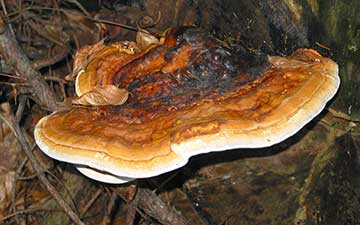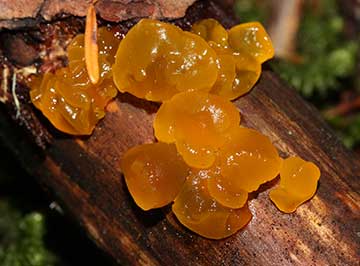The Nature of Cedar Mill
Tis’ the Season—for Mushrooms, That Is!
By Liz Fastenow, THPRD Natural Resources staff
During the winter, a stroll through the natural areas of our region can provide an excellent opportunity to notice things we may not see when the woods are alive with activity in other seasons. And remember, there’s no such thing as bad weather, just inappropriate clothing! But do be careful, many trails are quite slippery.
Both of these fungi grow on wood. The visible fruiting body is only a small portion of the organism.
 Red-Belted Conk Red-Belted Conk
The perennial red-belted conk (Fomitopsis pinicola) most often grows on dead wood but can occasionally be found on living trees. This fungus favors conifers (particularly Douglas fir) and is rare on deciduous trees. It is named for the red band found along the outer edge, and can sometimes get as large as three feet wide! You might see it in somewhat rounded or convex shape on the side of a tree (these are the young ones), or the well-known shelf-like shape of older specimens. The fungus rots out sapwood and heartwood, breaking down woody material and returning the nutrients to the soil. This makes it a major decomposer in Pacific Northwest forests.
Red-belted conks are one of the many shelf fungus species collectively known as “tinderwood fungus.” They provided early fire-makers with a source of tinder for starting fires. During rain and snow, when most fuel is wet or buried under snow, the insides of red-belted conks remain dry and are above the snow. The genus name Fomitopsis stems from this trait, with the root Fomes meaning “tinder” and opsis meaning “resembling” or “similar to.”
 Orange Jelly Fungus Orange Jelly Fungus
Have you ever wondered what those bright orange flecks peeking through the woods are? In the Portland area they are likely orange jelly fungus (Dacrymyces palmatus), which is found mostly on downed conifer wood. The orange jelly fungus is one of the Pacific Northwest’s most common jelly fungi, visible especially in the winter months when it’s wet outside. Jelly fungi lack any stem or gills typically associated with most fungi. This species in particular can be differentiated from similar yellowish jelly fungi called Witch’s Butter (Tremella aurantia) by a whitish attachment point to its substrate.
Images copyright Walter Siegmund (orange jelly fungus) and Jean-Pol Grandmont (red-belted conk) both Wikimedia Commons.
|
